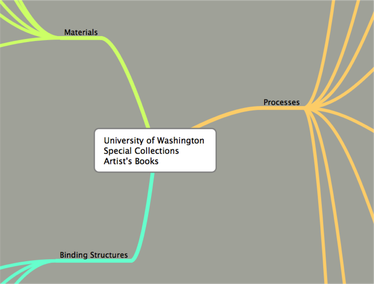Thesaurus Creation

(With Caroline Conley, Deborah Hamilton, and Cristina Linclau: LIS 537, Spring 2011).
Deliverables: Introduction; Domain Analysis; Functional Analysis. Visual map of language structure courtesy Cristina Linclau; submitted to Taxobank Terminology Registry.
Media: various
Primary skills developed: taxonomy creation and assessment; consulting work; time and project management; collaboration.
--
Description & Significance:
Creation of Indexing Languages (LIS 537), and its final project--creation of a thesaurus for a chosen domain--provided a marriage of organizational theory and practice that has done more to solidify my understanding of the taxonomic undertaking than perhaps any other course or project I've undertaken. Mapping our domain (the artists' books collection residing in the University of Washington's Special Collections) required not only reading up on the history and paradigms of the field, but synthesizing all of this information into a better understanding of how to think about artists' books in the ways those who are a part of the field do so, and about what we wanted our language to accomplish (see our Domain Analysis and Functional Requirements, above). Through this process I gained a sense of how important such groundwork is to a successful organizational scheme: in conversations with our client, it came out that several previous iterations of the project had not worked because they did not take into account the actual needs or limitations of the Special Collections staff working with the artists' books.
Deciding on a broad hierarchical approach and beginning to populate it with terms and definitions gleaned from our research and other specialized vocabularies was great experience with the nuts and bolts (and unexpected corkscrews) of creating a hierarchical organization system. By arguing through these decisions, I honed my ability to make expedient decisions that take into example as many considerations as possible. In the end, we produced 120 preferred terms and additional non-preferred terms, as well as notation, scope notes, source notes, and relationship specifications between terms, and an overall introduction to the language for potential indexers or users (see above). Overall, perhaps the most useful skill I gained was the ability to negotiate between the aesthetic desire for a perfectly organized model or system, and the reality of what a department or other client needs and can accommodate. In fact, what started as a class project has resulted in continuing effort to integrate our work with UW SC’s own database and online collections initiatives, and several members of our group (including myself) plan to continue working with them this summer to provide structure for this collection, one of the leading artists’ book collections in the country.
Deliverables: Introduction; Domain Analysis; Functional Analysis. Visual map of language structure courtesy Cristina Linclau; submitted to Taxobank Terminology Registry.
Media: various
Primary skills developed: taxonomy creation and assessment; consulting work; time and project management; collaboration.
--
Description & Significance:
Creation of Indexing Languages (LIS 537), and its final project--creation of a thesaurus for a chosen domain--provided a marriage of organizational theory and practice that has done more to solidify my understanding of the taxonomic undertaking than perhaps any other course or project I've undertaken. Mapping our domain (the artists' books collection residing in the University of Washington's Special Collections) required not only reading up on the history and paradigms of the field, but synthesizing all of this information into a better understanding of how to think about artists' books in the ways those who are a part of the field do so, and about what we wanted our language to accomplish (see our Domain Analysis and Functional Requirements, above). Through this process I gained a sense of how important such groundwork is to a successful organizational scheme: in conversations with our client, it came out that several previous iterations of the project had not worked because they did not take into account the actual needs or limitations of the Special Collections staff working with the artists' books.
Deciding on a broad hierarchical approach and beginning to populate it with terms and definitions gleaned from our research and other specialized vocabularies was great experience with the nuts and bolts (and unexpected corkscrews) of creating a hierarchical organization system. By arguing through these decisions, I honed my ability to make expedient decisions that take into example as many considerations as possible. In the end, we produced 120 preferred terms and additional non-preferred terms, as well as notation, scope notes, source notes, and relationship specifications between terms, and an overall introduction to the language for potential indexers or users (see above). Overall, perhaps the most useful skill I gained was the ability to negotiate between the aesthetic desire for a perfectly organized model or system, and the reality of what a department or other client needs and can accommodate. In fact, what started as a class project has resulted in continuing effort to integrate our work with UW SC’s own database and online collections initiatives, and several members of our group (including myself) plan to continue working with them this summer to provide structure for this collection, one of the leading artists’ book collections in the country.
